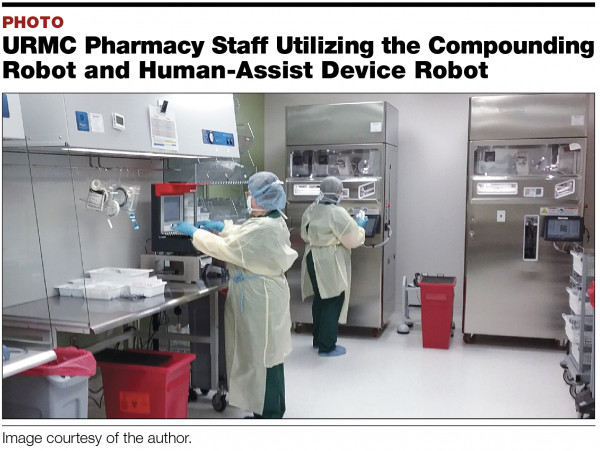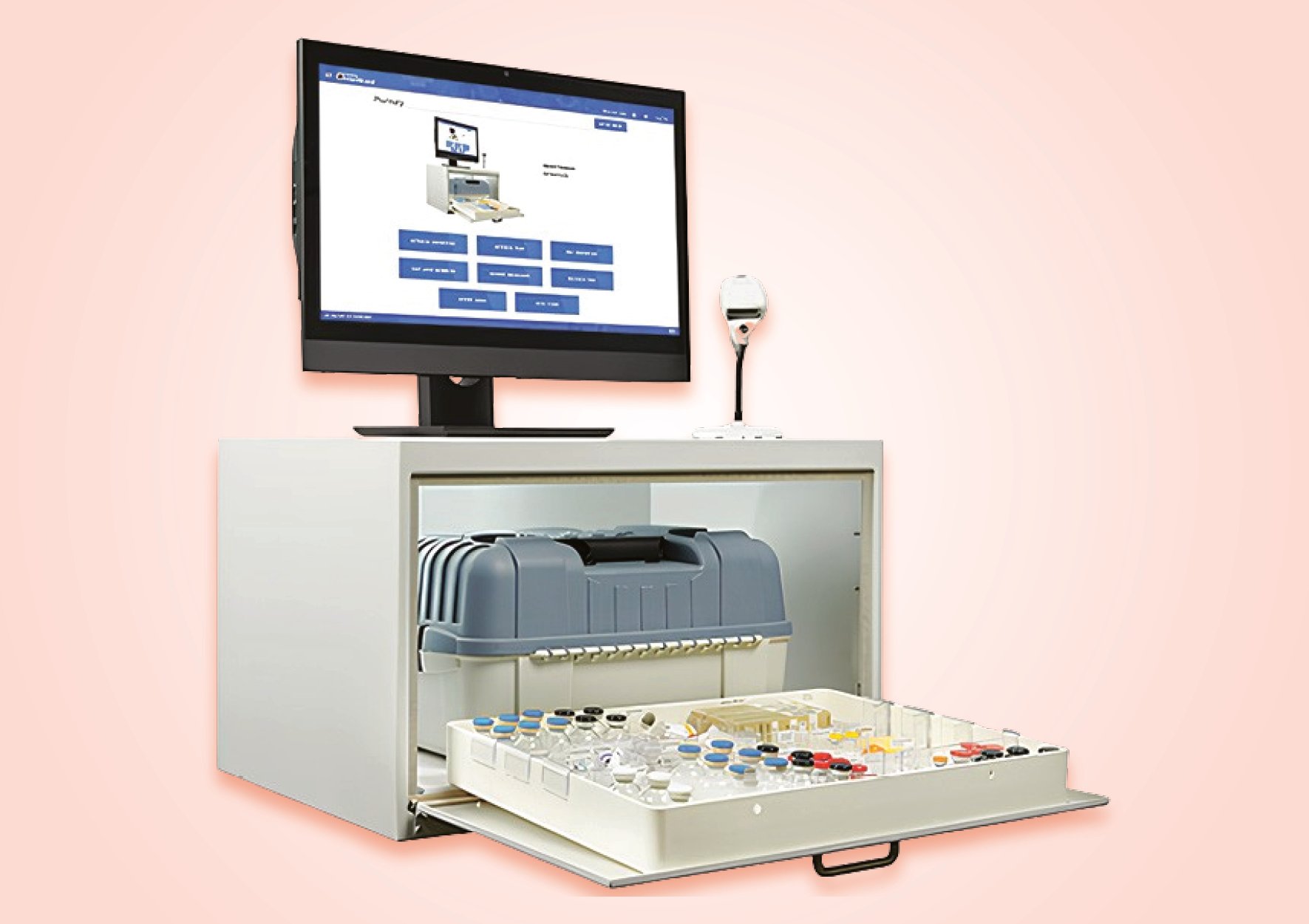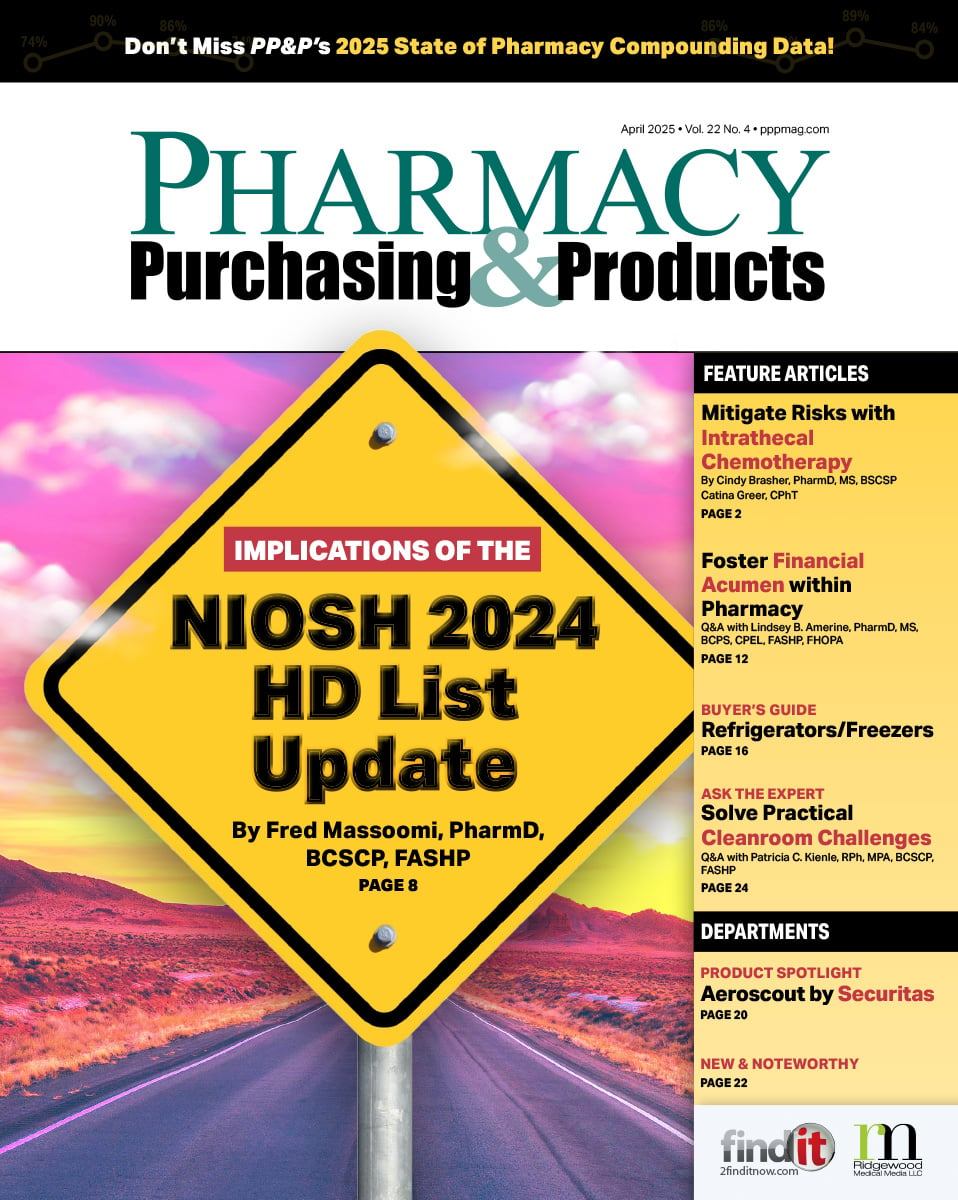- Show Menu
- Contact Us
- FAQs
- Reader Service
- Survey Data
- Survey Winners
- Testimonials
- Upcoming Events
- Webinars
- White Papers
Maximizing Automation in the IV Compounding Process
The risks of error or contamination in the sterile IV compounding process are well documented, and pharmacy leaders have been actively seeking ways to reduce these risks in recent years. As a result, the possibility of implementing automation, specifically IV workflow management systems, human-assist devices, and IV compounding robotics, is becoming more commonplace in discussions regarding sterile product production safety.
The University of Rochester Medical Center (URMC) has prioritized technology implementations to increase safety in a wide range of sterile production, including neonatal doses and hazardous medications. Our goal was to adopt a complete automation solution to address all types of preparations across all patient populations. To that end, we chose a safety technology solution that includes a non-hazardous IV compounding robot, hazardous IV compounding robots, IV workflow automation, and human-assist device robotics.
Pharmacy Purchasing & Products published an article in its July 2015 issue, Automating the Sterile Compounding Process, which describes the early stages of URMC’s IV automation implementation. This article provides an update on our progress, discusses challenges we addressed while maximizing these technologies, and identifies future goals.
Defining the Risks
The Institute for Safe Medication Practices (ISMP) supports implementing safety strategies in sterile compounding, stating1:
ISMP believes that bar code scanning of base solutions and ingredients should now be considered the minimum requirement for pharmacy IV admixture services, and that hospital leadership should support acquisition of technologies such as gravimetric verification of drug and diluent volumes and/or robotic image recognition.
At URMC, three key safety metrics form the cornerstone of sterile compounding safety goals, consistent with ISMP: bar code verification of ingredients, digital image capture of compounding processes and steps, and gravimetric verification of added components. A process that does not incorporate these critical steps is prone to introducing compounding errors.

The dangers of relying on manual processes and manual checking systems are well known. Although checks and double checks should be part of the overall safety strategy, they are too weak to function as the sole safety precaution. ISMP states, “Double checks will sometimes fail for a variety of reasons, not the least of which is that the process essentially depends on one fallible person assessing another fallible person’s work.”2 One study evaluating compounding accuracy at five hospitals reported a combined error rate of 9%.3 Multiple manipulations and a lack of technician training and experience were cited as factors increasing the risk of error.
The syringe pullback method of checking sterile preparations, wherein a pharmacy technician or pharmacist pulls back the plunger on an empty syringe to indicate the volume added to a compound, has been criticized as a weak safety strategy by many safety organizations, and highlighted ISMP, by stating that the syringe pullback method should never be used.4 Nevertheless, this process remains commonplace in many hospital IV rooms. Although some hospitals using the syringe pullback method have developed alternative strategies for checking high-risk preparations, such as visual verification of volumes drawn prior to addition to another solution in pediatric and oncology preparations, it is wise to eliminate the practice entirely. Reliance on visual measurement is flawed and error prone. For example, one study reported that when using volumetric technique in the preparation of chemotherapy compared with gravimetric methods, only 72% of preparations were within a ±5% tolerance of the expected dose.5
Failure Modes and Effects Analysis
URMC performed a Failure Modes and Effects Analysis (FMEA) on our sterile compounding process to identify areas of weakness, and determined that there were more than 30 process steps or decision points that were risk points for failure. Further evaluation revealed that the majority of these risks, including wrong product selection, incorrect volume added, incorrect diluent, an omitted ingredient, and missing a check in the multi-check process, could be mitigated by implementing safety technology. Moreover, our root-cause analysis groups noted that these weaknesses had already been identified as the primary causes in errors that had occurred at our institution. Both FMEA and root-cause analysis provided support for incorporating safety technology into the IV preparation process.
Initial Implementation Strategy
The automation implemented at URMC comprises the three key strategies for improving safety—bar code verification, digital imagery, and gravimetric confirmation—and also encompasses a wide range of sterile preparation to include batch production of standardized doses, hazardous medication production, customized neonatal solutions, as well as all other patient-specific dose compounding. To meet all of these needs, the solution comprises fully automated robotics, including robotics for hazardous medications; as well as automated human assist devices, including an integrated bar code scanner; high-resolution cameras; and a precision scale for weighing products for gravimetric checking. We also sought a system that would not allow staff to bypass critical safety checks—ie, we did not want a final label placed on a product until all safety checks had been performed.
After identifying the technology that would meet these rigorous requirements, a business plan with a primary focus on patient safety was developed. The financial case for adopting the technologies was built on improving safety and reducing medication costs by producing non-commercially available, standardized doses on-site. With approval from medical center leadership, an implementation plan was developed for a complete technology-enabled solution across all sterile preparation areas.
The most critical implementation step was educating staff to gain buy-in to the safety strategy. Engaging key stakeholders was crucial to this process. Highlighting the impact of human error, referenced in safety literature, as well as within the medical center, further underscored the need for a successful implementation and participation of all staff.
Developing a timeline for implementation required identifying our most significant risks, meeting financial goals, and implementing the parts of the strategy that were less complex related to interfaces with the electronic medical record (EMR). Given these factors, the following implementation order was established, with the goal of attaining success early in the project:
- IV robotics for anticipatory compounding
- Human-assist devices for batch preparation
- IV robotics for hazardous patient-specific compounding (launch of interface)
- Human-assist devices for patient-specific dose preparation
Addressing Challenges
Integration With the EMR
One of the major challenges in patient-specific production was to establish realistic expectations regarding the integration of the new technologies into the EMR and the electronic interface. Our initial goal was to establish a unidirectional interface, providing critical patient and order information from the EMR to the robotic technology. This involved significant assessment and testing, partnering our informatics and compounding services teams to resolve issues around inconsistent accounting for bag overfill, solution vehicle selection, dose rounding, and several other challenges. Due to the precision of the technology, the inbound information needed to precisely match the desired outcome. Patient-specific sterile compounds are often designed as customized solutions, which introduce potential variances from order to order. Therefore, interface development must allow flexibility in output based on dose ranges, patient populations, and ingredient preferences. Developing this type of interface requires ongoing resources in order to add new products and compounds.


Training
Training is always a focus when implementing new technology, and running parallel systems while slowly implementing a new workflow can increase training requirements. SOPs were developed for all processes to ensure standard practice and consistent outcomes. Technicians and pharmacists were selected for initial training based on their area of practice and interface to the technology. For non-patient specific anticipatory batch compounding, training was focused on the subset of individuals who would utilize the robots on a relatively limited basis, given that these batches could be planned in advance to utilize key staff in the process. This training would expand slowly over time based on the demands of batch production.
For patient-specific production, training was focused on a larger group of technicians and pharmacists, typically individuals who were involved in the compounding or electronic checking processes. This is a more demanding process given the need to reach a large portion of the staff, but tools provided by the vendor, as well as on-site training and competency programs, helped facilitate the process.
During this process we experienced both challenges and pleasant surprises:
- Increasing the number of daily doses produced via the oncology robot was contingent on a consistent staffing level and required extensive training related to robotics, which created delays in adding new medications to the process
- For non-hazardous products compounded on the human-assist devices, training requires significantly less time, as the device itself provides stepwise instruction to the user on the embedded digital screen, which increases process consistency and facilitates training
Challenges in Gravimetric Checking
The ability to perform gravimetric checking is contingent on the availability of specific gravities of medications, and although the availability of this data is growing, a lack of information can be a barrier to adding new medications to the robotic technology. With ongoing drug shortages and inconsistent availability of manufacturer-supplied products, it is necessary to build new protocols that include multiple potential ingredients of equivalent products. Cost also can be a factor, particularly when determining specific gravities of expensive oncology products (which can often reach into the thousands for a single product), as there will be product waste during the process. However, as this technology becomes more widely adopted, reliable resources for obtaining specific gravities, and vendor support in controlling costs, are becoming more available.
Labeling
Labeling is an important consideration in ensuring safe products for the end user. Prior to launching the first medications produced using the automation, a standardized labeling plan was developed, which included the location of critical information, use of font size and style, warning messages, as well as judicious use of color (when available) to conform to the anesthesia standards for medication class color-coding when producing premixed syringes for the OR environment.
Regulatory Changes
Regulatory changes are always an important factor considered in our assessment strategy for sterile compounding, as USP and the FDA have been relatively silent on automated technology in the past. However, it is anticipated that this will change as recognition increases regarding the safety benefits of IV automation. At the present time, interpretation of existing regulations and anticipation of requirements that may apply to automated devices can be challenging, and must be considered by individual facilities with respect to their compounding scope and practice. Regulatory agencies or the local state boards of pharmacy can provide insight, as well as help increase awareness regarding the technology as a long-range strategy to increase medication safety.
Developing a Downtime Plan
Whenever new technology is adopted, a downtime plan must be adopted. The strategy at URMC includes multiple layers of downtime planning; the goal is to ensure that a manual process for backup is available for all robotic production, incorporating similar safety checks where possible.
The downtime plan for the compounding robots and IV workflow management automation is contained in the EMR, and includes bar code verification of ingredients; recording of critical information, such as ingredient lot number and expiration date; and a pharmacist check that is documented as part of the protocol record in the EMR. In a catastrophic failure of all systems, a fully manual process with pharmacist setup check (ie, pre-check) and final checks would be utilized.
Maximizing Compounding Automation at URMC
Compounding technologies are currently implemented to varying degrees at URMC. Approximately 4000 doses per month are produced via robotic batch production (no human mixing), and an additional 2000 doses are prepared monthly using robotics to create dilutions for source products that are then repackaged manually into syringes using a pump. These processes represent approximately 20% of our batched sterile compounded doses. Since implementation, robots have produced 105,662 doses in a fully automated process, with an additional 40,285 doses from robotically produced source containers, for a total of 145,947 doses produced with robotic mixing dispensed to patients (see FIGURE 1).
Although we have a high degree of certainty regarding the accuracy, integrity, and sterility of these products, they all undergo a visual inspection and pharmacist verification prior to being released for patient use. In order to ensure products can safely be stored at room temperature, a subset of products with stability studies are quarantined for 14 days while undergoing sterility testing at an outside laboratory; medications are released only when sterility is confirmed at the end of the quarantine period.
For patient-specific production on human-assist devices, we initially identified four medications as part of our plan to automate our high-risk neonatal compounding: gentamicin, potassium chloride, magnesium sulfate, and vancomycin. Thereafter, we have developed a plan to add more medications to this process. We have produced 8726 doses for the pediatric population, representing approximately 17% of all pediatric sterile compounded doses. The breakdown between the NICU and other pediatric services is available in FIGURE 2; 14% of NICU preparations and 18% of other pediatric service preparations are compounded on these devices.
About 12 doses of patient-specific hazardous medications are produced for oncology patients per day, and the number of these doses is consistently increasing (see FIGURE 3). Since automation implementation, 1236 patient-specific hazardous doses have been produced via the technologies.
Additional safety advantages, beyond offsetting the compounding error risks inherent in a manual process, are gained when utilizing compounding automation. IV robotic compounding protects the compounding area from contamination in the environment, and also protects the IV room staff from exposure to the medications, which is critical when compounding hazardous drugs. The latter is part of our comprehensive plan to meet USP <800> guidelines moving forward.


Future IV Automation Goals
URMC is well on its way to reaching its goal of subjecting all sterile compounds to a minimum standard of bar code verification of ingredients and gravimetric validation. As we continue to standardize doses and concentrations, we will continue to expand batched compounding to increase utilization of robotic production for non-patient specific doses. Current robotic capacity and staffing would enable us to compound 12,000 doses per month utilizing the technology; when this occurs, more than 40% of premixed sterile doses could be delivered from fully automated robotic processes. For patient-specific hazardous production, the goal is to increase compounding capacity to an average of 40 doses per full production day, with the remainder of preparations compounded on human-assist devices, reaching close to 100% of hazardous doses prepared with all safety mechanisms.
Our strategy for producing patient-specific doses includes expanding beyond the first four medications in pediatrics to compound more than 80% of all pediatric doses using human-assist devices by the end of 2017. In parallel, we plan to expand into oncology services, including hazardous production that is not currently part of the fully automated robotic system, as well as products for the general adult population.
This strategy represents a significant step toward ensuring all patients receive medications produced using the safest sterile compounding processes available. It will be a long journey to reach 100% coverage of the three key safety elements, but we are confident that bar code verification, digital image capture, and gravimetric checks will be part of all sterile compounding processes across all patient populations within the next few years.
References
- Institute for Safe Medication Practices. Updated ISMP Guidelines Call for Increased Use of Technology/Automation in Sterile Compounding. September 19, 2016. http://www.ismp.org/pressroom/PR20160919.pdf. Accessed May 12, 2017.
- Institute for Safe Medication Practices. ISMP Guidelines for Safe Preparation of Compounded Sterile Preparations. Original Publication 2013, Revised 2016. www.ismp.org/Tools/guidelines/IVSummit/IVCGuidelines.pdf. Accessed May 12, 2017.
- Institute for Safe Medication Practices. ISMP Medication Safety Alert! Independent Double Checks: Undervalued And Misused: Selective Use Of This Strategy Can Play An Important Role In Medication Safety. June 13, 2013. www.ismp.org/newsletters/acutecare/showarticle.aspx?id=51. Accessed May 12, 2017.
- Flynn EA, Pearson RE, Barker KN. Observational study of accuracy in compounding i.v. admixtures at five hospitals. Am J Health-Syst Pharm. 1997;54(8):904-912.
- Poppe LB, Savage SW, Eckel SF. Assessment of final product dosing accuracy when using volumetric technique in preparation of chemotherapy. J Oncol Pharm Pract. 2014;22(1):3-9.

David F. Webster, BS Pharm, MSBA, is the associate director of pharmacy operations and director of the PGY1 pharmacy residency program at University of Rochester Medical Center, Rochester, New York. He received a BS in biochemistry from Saint Bonaventure University, a BS in pharmacy from the State University of New York at Buffalo, and an MSBA in operations management from the Simon School of Business at the University of Rochester.
Systems Scoop
Non-Hazards Compounding Robot: Omnicell's i.v. STATION
Hazardous Compounding Robot: Omnicell's: i.v. STATION ONCO
IV Workflow Automation: Omnicell's i.v. SOFT
Like what you've read? Please log in or create a free account to enjoy more of what www.pppmag.com has to offer.








